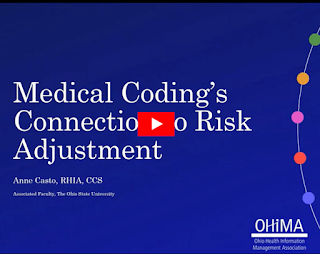Download the slides HERE.
Risk adjustment is a statistical process that takes into account the underlying health status and health spending of a patient by looking at the patient’s demographic data and diagnoses submitted on their claim to calculate a patient risk score. In the second video on this topic, the crucial role medical coding plays in determining the patient risk score is highlighted.
The Centers for Medicare and Medicaid Services Hierarchical Condition Category (CMS-HCC) model requires Medicare Advantage Organizations (MAOs) to submit ICD-10-CM diagnosis codes annually to determine the per member per month reimbursement rate. Diagnosis codes must be accurate and supported by the health record documentation to ensure reimbursement rates reflect the beneficiary’s health status.
Tune into this short video presented by Anne Casto, RHIA, CCS, where she discusses the role medical coding plays in determining a Medicare beneficiary’s risk score. She reviews how the risk score is calculated and the importance of coding completeness and accuracy.

Presented
by: Anne Casto, RHIA, CCS
Associated
Faculty, The Ohio State University
Connect
with Anne via email casto.3@osu.edu

